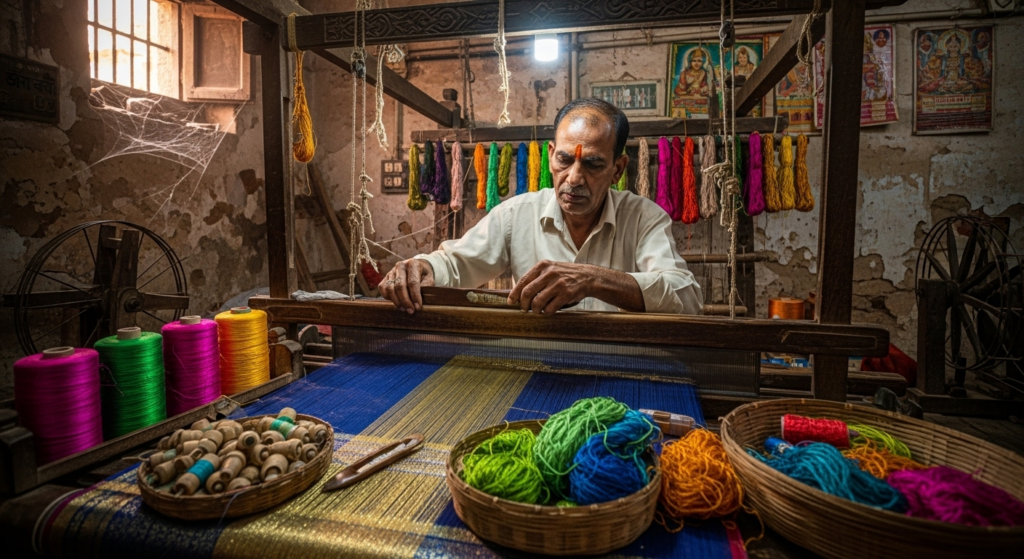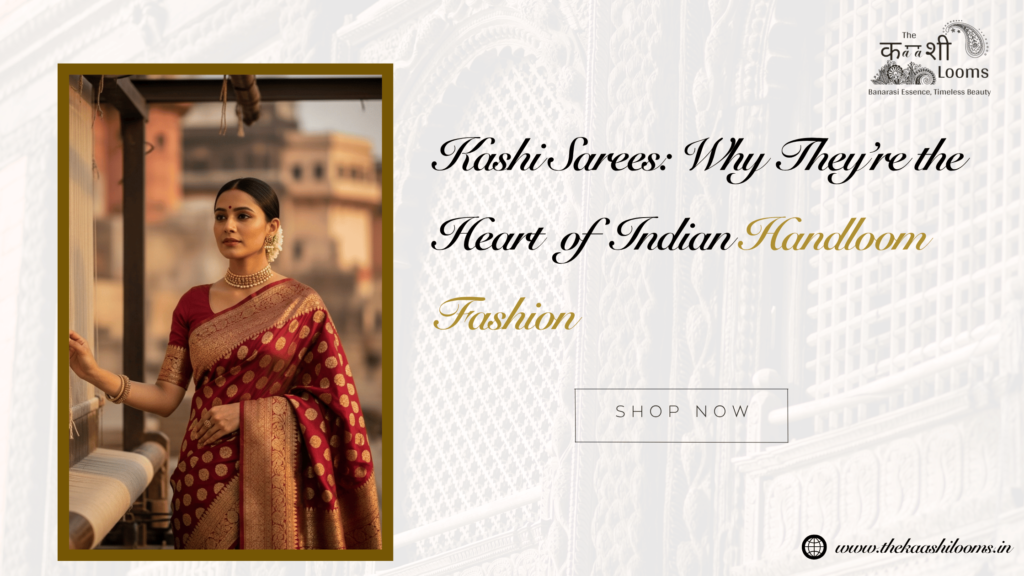Kashi Sarees: Why They’re the Heart of Indian Handloom Fashion
India’s love for sarees goes beyond just fashion—it’s culture, history, and artistry woven into six yards. Among the many regional variants, Kashi sarees (also known as Banarasi sarees) stand out as the crown jewels of Indian textiles. Known for their luxurious weaves, intricate motifs, and heritage-rich essence, these sarees are not just garments—they’re living traditions.
In this blog, we’ll explore what makes Kashi sarees the heart of Indian handloom fashion, how they are made, their historical significance, why every woman should own one, and how to style them for modern wardrobes.
A Weave of Heritage: The History of Kashi Sarees
Kashi, also known as Varanasi, is one of the oldest cities in the world—and its weaving tradition is equally ancient. The art of Banarasi weaving dates back over 2,000 years. Under the Mughal rule, this craft was refined to include Persian-inspired floral and paisley motifs, which are still prominent in today’s Kashi sarees.
From royal families to Bollywood stars, the Kashi saree has remained a symbol of prestige. The rich zari work, originally done in pure gold and silver threads, made it a must-have for weddings and festive occasions.

What Makes Kashi Sarees Unique?
Kashi sarees are not just beautiful—they are technically superior in many ways:
1. Handloom Excellence
Each saree takes anywhere from 15 days to six months to complete, depending on the complexity of the design. These are handloom sarees in the truest sense, woven on traditional looms by master artisans.
2. Zari Work
The hallmark of Kashi sarees is the intricate zari work—metallic threads interwoven with silk. The richness of this embroidery adds both weight and elegance.
3. Kadhwa Weaving
Unlike printed or embroidered sarees, the motifs in Kashi sarees are woven directly into the fabric using the Kadhwa technique, which ensures durability and luxurious texture.
4. Motifs that Tell Stories
From Mughal-inspired butis and jaals to Shikargah (hunting scene) motifs, every Kashi saree design tells a story of tradition, power, and beauty.
Types of Kashi Sarees
To the untrained eye, all Banarasi sarees may look similar. But connoisseurs know there are distinct types, each with its unique charm:
● Katan Silk Sarees
Pure silk sarees with tight weaves and a lustrous finish. Perfect for formal events and weddings.
● Organza (Kora) with Zari and Silk
Lightweight and airy, these sarees are ideal for summer weddings and day events.
● Georgette Banarasi Sarees
Flowy and modern, these are popular among younger brides and party-goers.
● Shattir Sarees
A budget-friendly version of traditional Banarasi sarees, but still stylish and elegant.
Kashi Sarees in Modern Fashion
While they remain rooted in tradition, Kashi sarees are also evolving with time:
Designers like Sabyasachi, Manish Malhotra, and Raw Mango are reinventing Kashi sarees with pastel tones and minimalist motifs.
Influencers and celebrities are pairing them with belts, jackets, crop tops, and even sneakers to give them a chic, millennial twist.
Brides are choosing Kashi sarees over lehengas for intimate, spiritual, and eco-friendly weddings.
Why Every Woman Should Own a Kashi Saree
Here’s why a Kashi saree deserves a spot in your wardrobe:
✨ Heritage Value
Wearing one is like wearing history—every motif and thread is centuries old in significance.
✨ Versatility
You can style a single Kashi saree in multiple ways—from weddings to formal office functions.
✨ Sustainability
Handloom sarees are eco-friendly. No synthetic fibers, no fast fashion guilt.
✨ Investment Piece
A pure silk Kashi saree can last for generations if cared for well. Think of it as fashion heirloom.
How to Style a Kashi Saree: Traditional & Modern Looks
✔ Traditional Bridal Look:
Pair a red or maroon Kashi saree with heavy gold jewelry, a sleek bun, and kohl-rimmed eyes. Perfect for weddings or festivals.
✔ Indo-Western Fusion:
Style your pastel Banarasi with a solid crop top or embroidered blouse and cinch the waist with a belt. Add statement earrings and block heels.
✔ Office or Event Look:
Choose a light Kashi cotton-silk saree. Keep the makeup minimal, pair with pearl studs, and wear block heels or juttis.
How to Identify an Authentic Kashi Saree
In a market flooded with machine-made imitations, knowing how to identify a real Kashi saree is essential:
Check the Reverse Side: Handwoven sarees show slight irregularities and float threads.
Ask for GI Tag: Authentic Banarasi sarees carry a Geographical Indication (GI) tag.
Touch & Feel: Pure silk feels soft but not slippery. Zari will have a slight metallic stiffness.
Weaving Detailing: Observe the motifs. If they are too perfect or pixelated, it might be powerloom.
How The Kashi Looms Supports Handloom Heritage
At The Kashi Looms, we don’t just sell sarees—we celebrate a culture. Every Kashi saree in our collection is:
100% handwoven by skilled artisans
Made with pure silk or sustainable blends
Quality-checked for authentic zari work
Delivered with GI certification (when applicable)
When you buy from us, you empower local artisans and help preserve a dying art form.
Caring for Your Kashi Saree
To ensure your saree lasts for decades:
Dry clean only
Wrap in muslin cloth
Avoid direct sunlight
Don’t hang with metal hangers
Final Thoughts
In a world full of fleeting trends, Kashi sarees remain timeless. They are not just a fashion statement—they are a tribute to craftsmanship, tradition, and heritage. Whether you wear one for your wedding, a special occasion, or just because you love sarees, you are carrying a piece of India’s soul.
So, if you’ve been wondering what your next wardrobe addition should be, let it be a Kashi saree—because nothing speaks elegance like something handwoven with love, history, and unmatched skill.
🛍️ Ready to Own a Piece of Heritage?
Explore our latest collection of Kashi sarees at TheKashiLooms.com and discover a timeless piece that reflects who you are—graceful, bold, and rooted in tradition.
Have a Question? Call or WhatsApp Us at +91 8545818338 – We’re Happy to Help!

